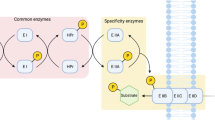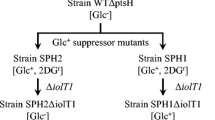Abstract
The transport of glucose by the solventogenic anaerobe Clostridium acetobutylicum was investigated. Glucose phosphoenolpyruvate (PEP)-dependent phosphotransferase system (PTS) activity was detected in extracts prepared from cultures grown on glucose and extract fractionation revealed that both soluble and membrane components are required for activity. Glucose PTS activity was inhibited by the analogue methyl α-glucoside, indicating that the PTS enzyme II belongs to the glucose-glucoside (Glc) family of proteins. Consistent with this conclusion, labelled methyl α-glucoside was phosphorylated by PEP in cell-free extracts and this activity was inhibited by glucose. A single gene encoding a putative enzyme II of the glucose family, which we have designated glcG, was identified from the C. acetobutylicum ATCC 824 genome sequence. In common with certain other low-GC gram-positive bacteria, including Bacillus subtilis, the C. acetobutylicumglcG gene appears to be associated with a BglG-type regulator mechanism, as it is preceded by a transcription terminator that is partially overlapped by a typical ribonucleic antiterminator (RAT) sequence, and is downstream of an open reading frame that appears to encode a transcription antiterminator protein. This is the first report of a glucose transport mechanism in this industrially important organism.




Similar content being viewed by others
References
Altschul SF, Madden TL, Schäffer AA, Zhang J, Zhang Z, Miller W, Lipman DJ (1997) Gapped BLAST and PSI-BLAST: a new generation of protein database search programs. Nucleic Acids Res 25:3389–3402
Aymerich S, Steinmetz M (1992) Specificity determinants and structural features in the RNA target of the bacterial antiterminator proteins of the BglG/SacY family. Proc Natl Acad Sci USA 89:10410–10414
Barabote RD, Saier MH Jr (2005) Comparative genome analyses of the bacterial phosphotransferase system. Microbiol Mol Biol Rev 69:608–634
Behrens S, Mitchell WJ, Bahl H (2001) Molecular analysis of the mannitol operon of Clostridium acetobutylicum encoding a phosphotransferase system and a putative PTS-modulated regulator. Microbiology 147:75–86
Binet MRB, Bouvet OM (1998) Transport of glucose by a phosphoenolpyruvate:mannose phosphotransferase system in Pasteurella multocida. Res Microbiol 149:83–94
Brückner R, Titgemeyer F (2002) Carbon catabolite repression in bacteria: choice of the carbon source and autoregulatory limitation of sugar utilization. FEMS Microbiol Lett 209:141–148
Christiansen I, Hengstenberg W (1999) Staphylococcal phosphoenolpyruvate-dependent phosphotransferase system—two highly similar glucose permeases in Staphylococcus carnosus with different glucoside specificity: protein engineering in vivo? Microbiology 145:2881–2889
Crutz AM, Steinmetz M (1992) Transcription of the Bacillus subtilis sacX and sacY genes, encoding regulators of sucrose metabolism, is both inducible by sucrose and controlled by the DegS–DegU signaling system. J Bacteriol 174:6087–6095
Debarbouillé M, Arnaud M, Fouet A, Klier A, Rapoport G (1990) The sacT gene regulating the sacPA operon in Bacillus subtilis shares strong homology with transcriptional antiterminators. J Bacteriol 172:3966–3973
Dürre P (1998) New insights and novel developments in clostridial acetone/butanol/isopropanol fermentation. Appl Microbiol Biotechnol 49:639–648
Knezevic I, Bachem S, Sickmann A, Meyer HE, Stulke J, Hengstenberg W (2000) Regulation of the glucose-specific phosphotransferase system (PTS) of Staphylococcus carnosus by the antiterminator protein GlcT. Microbiology 146:2333–2342
Krüger S, Hecker M (1995) Regulation of the putative bglPH operon for aryl-beta-glucoside utilization in Bacillus subtilis. J Bacteriol 177:5590–5597
Langbein I, Bachem S, Stülke J (1999) Specific interaction of the RNA-binding domain of the Bacillus subtilis transcriptional antiterminator GlcT with its RNA target, RAT. J Mol Biol 293:795–805
Lee J, Mitchell WJ, Blaschek HP (2001) Glucose uptake in Clostridium beijerinckii NCIMB 8052 and the solvent-hyperproducing mutant BA101. Appl Environ Microbiol 67:5025–5031
Lengeler JW, Jahreis K, Wehmeier UF (1994) Enzymes II of the phosphoenolpyruvate-dependent phosphotransferase systems: their structure and function in carbohydrate transport. Biochim Biophys Acta 1188:1–28
Mathews DH, Sabina J, Zuker M, Turner DH (1999) Expanded sequence dependence of thermodynamic parameters provides robust prediction of RNA secondary structure. J Mol Biol 288:911–940
Mitchell WJ (1996) Carbohydrate uptake and utilization by Clostridium beijerinckii NCIMB 8052. Anaerobe 2:379–384
Mitchell WJ (1998) Physiology of carbohydrate to solvent conversion by clostridia. Adv Microb Physiol 39:31–130
Mitchell WJ, Booth IR (1984) Characterization of the Clostridium pasteurianum phosphotransferase system. J Gen Microbiol 130:2193–2200
Mitchell WJ, Tangney M (2005) Carbohydrate uptake by the phosphotransferase system and other mechanisms. In: Dürre P (ed) Handbook on Clostridia. CRC Press pp165–185
Mitchell WJ, Shaw JE, Andrews L (1991) Properties of the glucose phosphotransferase system of Clostridium acetobutylicum NCIB 8052. Appl Environ Microbiol 57:2534–2539
Nölling J et al (2001) Genome sequencing and comparative analysis of the solvent-producing bacterium Clostridium acetobutylicum. J Bacteriol 183:4823–4838
O’Brien RW, Morris JG (1971) Oxygen and the growth and metabolism of Clostridium acetobutylicum. J Gen Microbiol 68:307–318
Postma PW, Lengeler JW, Jacobson GR (1993) Phosphoenolpyruvate: carbohydrate phosphotransferase systems of bacteria. Microbiol Rev 57:543–594
Robillard GT, Broos J (1999) Structure/function studies on the bacterial carbohydrate transporters, enzymes II, of the phosphoenolpyruvate-dependent phosphotransferase system. Biochem Biophys Acta 1422:73–104
Rutberg B (1997) Antitermination of transcription of catabolic operons. Mol Microbiol 23:413–421
Saier MH Jr, Reizer J (1992) Proposed uniform nomenclature for the proteins and protein domains of the bacterial phosphoenolpyruvate: sugar phosphotransferase system. J Bacteriol 174:1433–1438
Schmalisch MH, Bachem S, Stülke J (2003) Control of the Bacillus subtilis antiterminator protein GlcT by phosphorylation. Elucidation of the phosphorylation chain leading to inactivation of GlcT. J Biol Chem 278:51108–51115
Schnetz K, Stülke J, Gertz S, Krüger S, Krieg M, Hecker M, Rak B (1996) LicT, a Bacillus subtilis transcriptional antiterminator protein of the BglG family. J Bacteriol 178:1971–1979
Stülke J, Martin-Verstraete I, Zagorec M, Rose M, Klier A, Rapoport G (1997) Induction of the Bacillus subtilis ptsGHI operon by glucose is controlled by a novel antiterminator, GlcT. Mol Microbiol 25:65–78
Stülke J, Arnaud M, Rapoport G, Martin-Verstraete I (1998) PRD—a protein domain involved in PTS-dependent induction and carbon catabolite repression of catabolic operons in bacteria. Mol Microbiol 28:865–874
Tangney M, Mitchell WJ (2000) Analysis of a catabolic operon for sucrose transport and metabolism in Clostridium acetobutylicum ATCC 824. J Mol Microbiol Biotechnol 2:71–80
Tangney M, Mitchell WJ (2004) Clostridium tetani encodes a phosphocarrier protein, HPr. Microbiology 150:525–526
Tangney M, Mitchell WJ (2005) Regulation of catabolic gene systems. In: Dürre P (ed) Handbook on clostridia. CRC Press pp583–605
Tangney M, Brehm J, Minton N, Mitchell WJ (1998) A gene system for glucitol transport and metabolism in Clostridium beijerinckii NCIMB 8052. Appl Environ Microbiol 64:1612–1619
Tangney M, Winters GT, Mitchell WJ (2001) Characterization of a maltose transport system in Clostridium acetobutylicum ATCC 824. J Ind Microbiol Biotechnol 27:298–306
Tangney M, Galinier A, Deutscher J, Mitchell WJ (2003) Analysis of the elements of catabolite repression in Clostridium acetobutylicum ATCC 824. J Mol Microbiol Biotechnol 6:6–11
Zagorec M, Postma PW (1992) Cloning and nucleotide sequence of the ptsG gene of Bacillus subtilis. Mol Gen Genet 234:325–328
Author information
Authors and Affiliations
Corresponding author
Rights and permissions
About this article
Cite this article
Tangney, M., Mitchell, W.J. Characterisation of a glucose phosphotransferase system in Clostridium acetobutylicum ATCC 824. Appl Microbiol Biotechnol 74, 398–405 (2007). https://doi.org/10.1007/s00253-006-0679-9
Received:
Revised:
Accepted:
Published:
Issue Date:
DOI: https://doi.org/10.1007/s00253-006-0679-9




